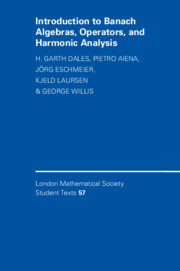Book contents
- Frontmatter
- Contents
- Preface
- Part I Banach algebras
- Part II Harmonic analysis and amenability
- 8 Locally compact groups
- 9 Group algebras and representations
- 10 Convolution operators
- 11 Amenable groups
- 12 Harmonic analysis and automatic continuity
- Part III Invariant subspaces
- Part IV Local spectral theory
- Part V Single-valued extension property and Fredholm theory
- Index of symbols
- Subject index
12 - Harmonic analysis and automatic continuity
Published online by Cambridge University Press: 29 December 2009
- Frontmatter
- Contents
- Preface
- Part I Banach algebras
- Part II Harmonic analysis and amenability
- 8 Locally compact groups
- 9 Group algebras and representations
- 10 Convolution operators
- 11 Amenable groups
- 12 Harmonic analysis and automatic continuity
- Part III Invariant subspaces
- Part IV Local spectral theory
- Part V Single-valued extension property and Fredholm theory
- Index of symbols
- Subject index
Summary
Knowledge of the structure of L1(G) can be used to show that derivations from L1(G) are automatically continuous when G is abelian, compact, or is in one of several other classes. However it is not known whether such derivations are continuous for every locally compact group G. Work on this problem leads to further questions in abstract harmonic analysis.
Automatic continuity of derivations
It was shown by Ringrose (1972) that every derivation from a C*-algebra A is automatically continuous. Powerful general techniques for proving automatic continuity results have been developed from this and earlier work; see Part I and the substantial account in Dales (2000). The following general method for proving automatic continuity of derivations was given by Jewell (1977).
Theorem 12.1.1Let A be a Banach algebra such that:
every closed two-sided ideal with finite codimension in A has a bounded approximate identity; and
if I is a closed two-sided ideal with infinite codimension in A, then there are sequences (anand (bn) in A such that bna1…an−1 ∉ I, but bna1…an ∈ I for each n ≥ 2.
Then every derivation D : A → X, where X is a Banach A-bimodule, is continuous.
Condition 2 of the theorem is used to show that the continuity ideal (see Part I and Exercise 12.4.1) of any derivation D : A → X cannot have infinite codimension. A variant of the Main Boundedness Theorem of Bade and Curtis (see Theorem 5.2.2) is used to show this.
- Type
- Chapter
- Information
- Publisher: Cambridge University PressPrint publication year: 2003



